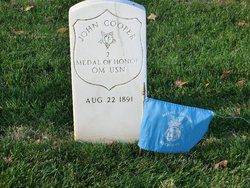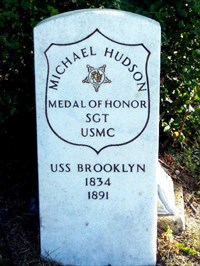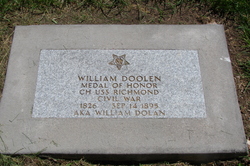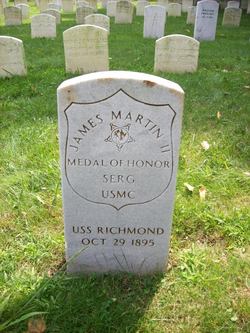Mobile Bay, Alabama
5th August 1864 
After the fall of New Orleans in April 1862, Mobile became the most important of the Confederacy’s Gulf ports. It was blockaded rather poorly by the US Navy which was constrained by the need to divert forces to the Mississippi. By August 1864 the Union was ready to impose a total blockade on the bay.
The Entrance to Mobile Bay was guarded by two forts, Fort Gaines and Fort Morgan. In addition, obstructions and torpedo defences ( a term for what would later be sea mines) had been placed across the entrance and a small Confederate fleet was stationed in the bay. The minefield was designed to force sea traffic to sail close to Fort Morgan, the strongest of the harbour’s forts. The Confederate fleet consisted of one Ironclad, the CSS Tennessee, and four gunboats.
The Union plan was a combined Naval/Army action although the Navy saw most of the action on August 5th. The Army, due to confusion over orders, landed at Gianes Island before the Navy was ready to move. TheConfederates assuming an attack on Fort Gaines was imminent, reinforced the fort which actually worked in the Unions favour. The Naval plan was to sail through the entrance to the bay with the 14 wooden-hulled ships of the Union fleet lashed together in pairs sailing close to the Confederate mines, while four Ironclad sailed nearest the forts to draw Confederate fire.
The battle commenced at dawn on 5th August 1864 with the four Ironclad opening fire on Fot Morgan. Shortly after, the Confederate fleet moved to the bay entrance. The Ironclad Tecumseh disregarded its orders to sail near the fort and immediately headed directly for the CSS Tennessee. This course brought Tecumseh into the minefield where she struck a mine and sank within minutes.
USS Brooklyn
The USS Brooklyn was in the lead pair of wooden-hulled ships, primarily because she had a “cow-catcher” mine-clearing device fitted but also because she had four forward-firing guns. Tecumseh’s actions caused confusion aboard the USS Brooklyn, whose orders were to sail right of the minefield and left of Tecumseh. When the Ironclad hit the mine, Brooklyn attempted to clear more mines under her bow. This of course slowed down the rest of the vessels following behind her, putting them in danger of being sunk by the guns of Fort Morgan. Admiral Farragut ordered to fleet to pass the Brooklyn. USS Brooklyn did subsequently enter the bay, where the CSS Tennessee attempted unsuccessfully to ram her.
Two of USS Brooklyn’s 23 Medal of Honor recipients on the day were Irish. The ship lost 54 dead and 43 wounded in the battle.
John Cooper 
Cooper was born on 24th July 1826 in Dublin. He was a Coxswain at Mobile Bay when he earned the first of his two Medals of Honor. Part of his citation reads that “Cooper fought his gun with skill and courage throughout the furious battle”.#
John Cooper’s second award was for rescuing a man trapped in a in Mobile on 26th April 1865.
Cooper died on 22nd August 1891 and is buried in Cypress Hills National Cemetery, Brooklyn, New York.
Michael Hudson
Michael Hudson was born in Sligo in 1834. He joined the US Marine Corps in New York on 12th September 1861. Aboard the USS Brooklyn at Mobile Bay Sgt Hudson commanded a gun “with skill and courage throughout the furious 2-hour battle “ with the Tennessee.
Hudson was discharged from the Marine Corps after the war and he died on 28th December 1891 in Charlotte Michigan where he is buried in Maple Hill Cemetery.
USS Galena
Galena was tied to the port side of the USS Oneida for the passage past Fort Morgan. The ships were the last pair in the Union column. The Oneida’s engines were disable by fire from the fort and both ships were sailing under power from the Galena when they were engaged by the Tennessee at short range. Galena only fired 6 shots at the Confederate ship. Two Irishmen earned Medals of Honor on the Galena.
[/img][/center]
William Gardner was a Seaman aboard the USS Galena. Born in Ireland in 1832, he joined the Navy in New York. His citation reads that Gardner “behaved with conspicuous coolness under the fire of the enemy”. He later became Ship’s Cook. His place and date of death are unknown.
Edward Martin was born in Ireland in 1840 and joined the Navy in Philadelphia. He was a Quartermaster aboard the Galena at Mobile Bay and received his Medal of Honor for performing his duties “with skill and courage throughout the action”
Edward or sometimes Edwin Martin died in New York on 23rd December 1901 and is buried in Cypress Hills National Cemetery, Brooklyn, New York.
USS Chickasaw
The Chickasaw was one of the four Ironclad Monitors used in the Battle of Mobile Bay. She was the last ship in the starboard column and she and the Winnebago were detailed to engage the guns of Fort Morgan while the wooden-hulled ships passed through the entrance to the bay. Chickasaw opened fire at 7.10 am and fored 75 rounds at the fort in an hour and a half long action. She then sailed into the bay and engaged the Tennessee. Chickasaw’s part in the engagement with the Tennessee lasted an hour during which she fired 52 shots, damaging some of the stern gun ports.
Andrew Jones
Andrew Jones was a Chief Boatswain's Mate aboard the USS Vincennes. Despite the fact that his enlistment was up he volunteered for service in the Battle of Mobile Bay and transferred to the USS Chickasaw. He “ carried out his duties gallantly throughout the engagement with the enemy”, earning the Medal of Honor.
Jones was born in Limerick in 1835. His place and date of death are unknown.
USS Hartford
The USS Hartford was the flagship of Admiral Farragut, commander of the naval attack on Mobile Bay. Two of the twelve crewmen of the Hartford to receive te Medal of Honor were Irish.
Richard Dunphy 
Richard Dunphy was born in Ireland on 12th December 1841 and joined the US Navy in New York on 17th December 1863. He was a Coal Heaver aboard the USS Hartford. He received the Medal of Honor for performing his duties “with skill and courage throughout this fierce engagement”. Dunphy lost both arms to Confederate shell fragments and was invalided out of the Navy. He moved to Wisconsin and married in 1868. Dunphy died in Vallejo, California on 23rd November 1904. He s buried in St Vincent's Cemetery, Vallejo.
Thomas O'Connell was born in Ireland in 1842. He joined the Navy from New York and was a Coal Heaver aboard the USS Hartford. Although he was a patient in the sick bay, O'Connell voluntarily reported to his station performed his duties with zeal and courage until his right hand was severed by an enemy shellburst. He lived on until 29th August 1899 though and is buried in Whitefield, Maine.
His Medal of Honor is held by the National Museum of the US Navy.
USS Lackawanna
The Lackawanna was in the fourth pair of wooen-hulled ships to enter Mobile Bay. She rammed the CSS Tennessee during the battle and caused the Confederate ship to list. In attempt to ram her again, Lackawanna collided with the USS Hartford. Two of her Irish crewmen received the MOH after the battle.
Michael Cassidy 
Michael Cassidy was a Landsman aboard the USS Lackawanna. He was a sponger of one of the guns and received the Medal of Honor for his coolness under fire. Cassidy was born in Ireland in 1837 and died in Hampton, Virginia on 18th March 1908. He is buried in Hampton National Cemetery.
Patrick Dougherty
Patrick Dougherty was also a Landsman aboard the USS Lackawanna. He was born in 1844 in Ireland. He was awarded the MOH for acting “gallantly without orders when the powder boy at his gun was disabled under the heavy enemy fire, and maintained a supply of powder throughout the prolonged action.” His date and place of death are unknown.
USS Metacomet
The Metacomet was a gunboat which entered Mobile Bay lased to the USS Hartford. Inside the bay she was one of those ships assigned to engage the four Confederate gunboats. Metacomet chased down and captured the CSS Selma and then proceeded to the rescue of the survivors of the USS Tecumseh.
Patrick Murphy 
Patrick Murphy was born in Waterford on 15th January 1823. He went to sea at the age of 14 aboard a merchant ship trading between the UK and America. Aged 17 he joiend the Royal Navy and served aboard HMS Montreal before emigrating to the US in 1842. In 1844 he joined the US Navy in Pennsylvania and by 1864 he was a Boatswain's Mate on the USS Metacomet. His Medal of Honor Citation reads that “despite damage to his ship and the loss of several men on board as enemy fire raked her decks, Murphy performed his duties with skill and courage”.
Patrick Murphy served in the Navy until 1885. He died in Erie, Pennsylvania on 1st December 1896 and is buried in Trinity Cemetery, Erie.
USS Oneida
The USS Oneida spent the battle lashed to the USS Galena with her engines damaged by shellfire from Fort Morgan. One Irish sailor of her crew and an Irish Marine serving aboard her received the Medal of Honor.
John Preston
John Preston was born in Ireland in 1841 and joined the navy in Boston, serving as a Landsman aboard USS Oneida. Preston was severely wounded during the battle but continued at his station until ordered to the Surgeon. In the sick bay he assisted in the care of the injured despite serious injuries to both eyes. His place and date of death are unknown.
James Roantree 
James Roantree was born in Dublin in 1835 and joined the US Marines in Brooklyn, New York on January 15th 1858. In 1864 he was a Sergeant aboard the USS Oneida. His medal citation reads that Sgt. Roantree performed his duties with skill and courage throughout the furious battle which resulted in the surrender of the rebel ram Tennessee and in the damaging and destruction of batteries at Fort Morgan. He died on 24th February 1873, and is buried in New Calvary Cemetery, Mattapan, Massachusetts.
USS Richmond
USS Richmond was one of the second pair of wooden-hulled ships to attack Mobile Bay. She was one of Farragut’s biggest ships and was instrumental in the capture of the Tennessee. Despite this she suffered no fatal casualties in the battle. Two Irish men in her crew received the Medal of Honor.
William Doolen 
William Doolen was born in 1841 and joined the navy in Philadelphia, serving as a Coalheaver. Though wounded in the head during the battle Doolen refused to leave his station and “rendered gallant service throughout the prolonged battle”. He died in Cheyenne, Wyoming on 14th September 1895 and is buried in Mount Olivet Cemetery.
James Martin 
James Martin was born in Derry in 1826 and joined the US Marines in Philadelphia on 9th July 1847. By 1864 he was a Sergeant aboard USS Richmond in command of one of her guns. His medal citation reads that “Sgt. Martin fought his gun with skill and courage” in the battle.
After 32 years service in the Marines, James Martin retired to Philadelphia where he died on 29th October 1895. He is buried in Mount Moriah Cemetery.
With the Confederate fleet knocked out th forts were unable to withstand the Union siege for longer than a couple of weeks. By 23rd August they had surrendered and the last Confederate port was now blockaded.